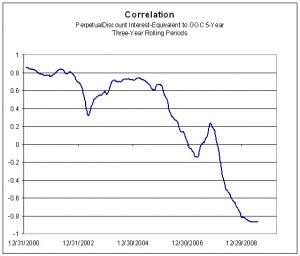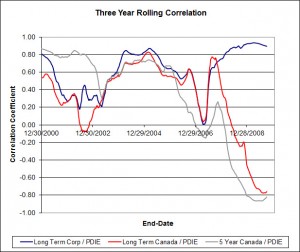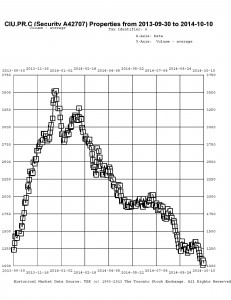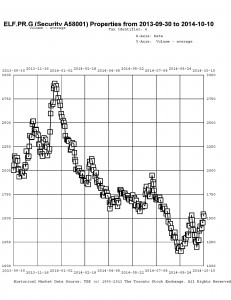Paul Asquith, Thomas R. Covert and Parag Pathak have written a paper titled The Effects of Mandatory Transparency in Financial Market Design: Evidence from the Corporate Bond Market:
Many financial markets have recently become subject to new regulations requiring transparency. This paper studies how mandatory transparency affects trading in the corporate bond market. In July 2002, TRACE began requiring the public dissemination of post-trade price and volume information for corporate bonds. Dissemination took place in Phases, with actively traded, investment grade bonds becoming transparent before thinly traded, high-yield bonds. Using new data and a differences-in-differences research design, we find that transparency causes a significant decrease in price dispersion for all bonds and a significant decrease in trading activity for some categories of bonds. The largest decrease in daily price standard deviation, 24.7%, and the largest decrease in trading activity, 41.3%, occurs for bonds in the final Phase, which consisted primarily of high-yield bonds. These results indicate that mandated transparency may help some investors and dealers through a decline in price dispersion, while harming others through a reduction in trading activity.
…
Proponents of TRACE argue that transparency makes the corporate bond market accessible to retail clients, enhances market integrity and stability, and provides regulators greater ability to monitor the market. They reason that with the introduction of transparency, price discovery and the bargaining power of previously uninformed participants should improve (NASD 2005). This in turn should be reflected in a decrease in bond price dispersion and, if more stable prices attract additional participants, an increase in trading activity (Levitt 1999).
Opponents of TRACE object to mandatory transparency, saying that is unnecessary and potentially harmful. They argue that “transparency would add little or no value” to highly liquid and investment grade bonds since these issues often trade based on widely known US Treasury benchmarks (NASD 2006). They further argue that if additional information about trades was indeed valuable, then third‐party participants would already collect and provide it, a view that dates back to Stigler (1963). Opponents also forecast adverse consequences for investors since, if price transparency reduces dealer margins, dealers would be less willing to commit capital to hold certain securities in inventory making it more difficult to trade in these securities. The Bond Market Association argued that the adverse effects of transparency may be exacerbated for lower‐rated and less frequently traded bonds (Mullen 2004). Lastly, opponents saw TRACE as imposing heavy compliance costs, particularly for small firms who do not self‐clear (Jamieson 2006). Thus, opponents argue that market transparency reduces overall trading activity and the depth of the market. Not surprisingly, similar arguments for and against transparency have resurfaced in response to the recent introduction of the Dodd‐Frank’s post‐trade transparency requirements for swaps (Economist 2011).
With all respect to the various debaters, and while recognizing that the above is an extremely quick summary of their thoughts, I have to say that all the quoted arguments miss the mark. The fundamental question is: what is the corporate bond market for? I claim that the purpose of the corporate bond market is to allow issuers to access capital at as little cost as possible; therefore, all regulation related to the bond market should be first examined through the lens of ‘what will this do to new issue spreads?’. While this is not the only thing to be addressed, it is the most important thing and it is something I rarely see addressed.
It was addressed, however, in a 2012 comment letter to FINRA from SIFMA:
Issuers face the ultimate risk from decreases to market liquidity since the public dissemination of trade information, as a general matter, makes broker-dealers less willing to take risk on large size trades. A reduction in liquidity will cause institutional investors to demand greater yield from issuers (to compensate for the reduced liquidity), or to simply refuse to buy new issues in meaningful size. Therefore, a careful balance between transparency and the preservation of liquidity must be struck. Data shows that dealers have recently chosen to (or been forced to, in the case of rules like the Volcker Rule) put capital to work elsewhere. This means that institutional investors will face greater difficulty selling a larger sized amount of an issue. Pre-TRACE, and pre-financial crisis, dealers provided a much larger outlet where they would take the risk temporarily while they worked to uncover a buyer. This outlet has been much reduced in recent years, due to a combination of regulation and other market structure issues. The real liquidity differential for larger vs. smaller “on the run” amounts has been meaningfully amplified, and eliminating caps on disseminated volumes would exacerbate this problem. At a much more specific level, it is more difficult to issue securities in smaller sizes when participant’s transactions are immediately made public and expose exact amounts taken down by particular investors. An increase in the dissemination caps will increase the threshold where these securities issuances are somewhat more challenging, and disproportionately harm smaller issuers. In each case, the macro and the granular, the result is a higher cost of capital for issuers.
Letting that issue slide for a moment and returning to Asquith, Covert and Pathak:
FINRA implemented TRACE in Phases because of concerns about the possible negative impact of transparency on thinly traded, small issue and low‐credit rated bonds. Examining issue size across all Phases, we find that trading activity decreases more for large issue size bonds, but that the reduction in price dispersion is uncorrelated with issue size. Credit ratings, however, matter for both trading activity and price dispersion. High‐yield bonds experience a large and significant reduction in trading activity, while the results are mixed for investment grade bonds. High‐yield bonds also experience the largest decrease in price dispersion, but price dispersion significantly falls across all credit qualities. Therefore, the introduction of transparency in the corporate bond market has heterogeneous effects across sizes and rating classes.
…
Price dispersion also decreases due to TRACE. This decrease is significant across bonds that change dissemination in Phases 2, 3A, and 3B, but is largest, 24.7%, for Phase 3B bonds. This finding is also robust across different measures of price dispersion and alternative regression specifications. Moreover, event studies show that the fall in price dispersion occurs immediately after the start of dissemination. It is important to note, if the transparency introduced in Phase 1 affects bonds that become transparent in subsequent Phases, our estimates are probably lower bounds on TRACE’s overall impact.
…
There are several welfare implications of increased transparency in the corporate bond market. One consequence is that it may change the relative bargaining positions of investors and dealers, allowing investors to obtain fairer prices at the expense of dealers. The reduction in price dispersion should allow investors and dealers to base their capital allocation and inventory holding decisions on more stable prices. Therefore, the reduction of price dispersion likely benefits customers and possibly, but not necessarily, dealers.
The implications of a reduction in trading activity are not as clear. Whether a reduction in trading activity is desirable depends on why market participants trade. A decrease in trading activity may be beneficial if much of the trading in a bond is unnecessary “noise” trading. On the other hand, if most trading is information‐based, a decrease in trading activity may slow down how quickly prices reflect new information. In addition, if the decrease in trading activity is the result of dealers’ unwillingness to hold inventory, transparency will have caused a reduction in the range of investing opportunities. That is, even if a decline in price dispersion reflects a decrease in transaction costs, the concomitant decrease in trading activity could reflect an increased cost of transacting due to the inability to complete trades.
Our results on the corporate bond market have two major implications for the current and planned expansions of mandated market transparency. The implicit assumption underlying the proposed TRACE extensions and the use of TRACE as a template for regulations such as Dodd‐Frank is that transparency is universally beneficial. First, it is not clear that transparency for all instruments is necessarily beneficial. Overall, trading in the corporate bond market is large and active, although, as seen, not comparable across all types of bonds. Many over‐the‐counter securities are similar to the bonds FINRA placed in Phase 3B. That is, they are infrequently traded, subject to dealer inventory availability, and trading in these securities is motivated by idiosyncratic, firm‐specific information. Therefore, the expansion of TRACE‐inspired regulations, such as those for 144a bonds, asset‐ and mortgage‐backed securities, and the swap market, may have adverse consequences on trading activity and may not, on net, be beneficial.
Second, our results indicate that transparency affects different segments of the same market in different ways. As a consequence, our results provide empirical support for the view that not every segment of each security market should be subject to the same degree of mandated transparency. Both academic commentators (French et al., (2010), Acharya et al. (2009)) and leading industry associations (e.g., Financial Services Forum, et al., (2011)) have articulated this position. Despite these recommendations, the expansion of transparency by the Commodity Futures Trading Commission (CFTC) in various swap markets, i.e. interest rate, credit index, equity, foreign exchange and commodities, in December 2012 and February 2013 was immediate for all swaps in those markets. This stands in sharp contrast to FINRA’s cautious implementation of TRACE in Phases. The fact that the effect of transparency varies significantly across categories of bonds within the corporate bond market suggests that additional research will be required to evaluate the tradeoffs associated universal transparency in other over‐the‐counter securities.
There is one assertion in the above with which I take particular issue: One consequence is that it may change the relative bargaining positions of investors and dealers, allowing investors to obtain fairer prices at the expense of dealers. Long time Assiduous Readers will probably be snickering to themselves, having determined that I am probably going to complain about the use of the word “fairer”, since I don’t know what “fair” means, and they’re quite right.
By “fair”, I assume the authors mean “at a price closer to the dealers’ cost than otherwise”, but that is not necessarily “fair” when examined in a broader context.
Suppose, for instance, that you are a bond dealer – horns, pitchfork, cloven hooves and all – and somebody asks you to bid on something. OK, so you do – but why do you? The answer, of course, is to make a profit and as a rational economic actor you seek to maximize your profit. But you’re not seeking to maximize your profit on every possible transaction or even to maximize your gross profit; you’re seeking to maximize the annual profit of your desk expressed as a fraction of your capital. This has a number of implications; for instance, you might give regular customers who deal exclusively with you slightly better prices than the other ones, simply to ensure that these guys never have any reason to consider going anywhere else.
But the most important consideration for purposes of this discussion is the question of maximizing profitability as a fraction of capital. That’s what determines the firm’s capital allocation and that’s what determines your bonus. And for a single given transaction, we can write the following equation:
Desirability = (Sell – Buy) / (Capital * Days)
Where the gross profitability is the Sell price less the Buy price, Capital is the amount of capital used when financing the position and Days is the number of days you have to hold the thing in inventory until it’s sold (or bought, if the position was initiated with a short sale). In this equation I am ignoring the Carry (the difference between the yield of the bond and the cost of financing it); I’m also ignoring default risk and lots of other considerations, with the objective of keeping this simple.
Under the pre-TRACE regime, one way to maximize trade desirability was, obviously, to maximize the difference between your Sell and Buy prices, but TRACE makes that a lot more difficult; after all, that’s the whole point of TRACE and Asquith, Covert and Pathak have made a solid argument that it is not happening to the same extent under TRACE as it was in the good old days. So for practical purposes, when the dealer is putting a price on taking a position, he is doing so with the knowledge that gross profit is capped.
The “Capital” term in the simplified equation is set by regulation and the bond desk has no control over it. As far as they’re concerned, it’s a constant.
Therefore, in order to increase the Desirability of the trade, the only avenue left open to the dealer is Days, which is inversely related. If they can make their $0.50 per bond profit in one day, that’s a whole lot better than if it takes a month! Therefore, when taking a position, they will concentrate their energies on how they will flatten their position. This will, of course, be much easier if they offer their position to a potential buyer at an attractive price. Therefore, I claim, TRACE will lead to the initial seller getting a really lousy price for his bond, which is turned over in short order to the ultimate buyer who gets a really good price.
There is evidence for this in the secondary GIC market, which has to be one of the most ridiculously infinitesimal markets in the world, but which exists at the major dealers not so much as a money-maker, but as a service to clients. Some GICs are transferrable and the dealer will buy them from the owner at a really, really lousy price – I think the bid yield is about 150bp over the market rate, but I confess I’m not too sure of that. I have a major dealer’s offering sheet from 2012 on hand, which is headed by the statement: “ALL Secondary GICS offered at approximately +50bps over today’s Best GIC Rates (on the [Redacted] System”
This is a great deal for buyers, and I have often recommended to clients that they open accounts at a major dealer for the purpose of access to new issues and access to secondary GICs. And why I am I saying this? Because I think the buyer will get a “fair” price, just like teacher talked about in kindergarten? Hell, no! It’s because I think the buyer will get a really good price, courtesy of the really, really shitty price that was offered to the poor sucker who needed to cash his GIC early.
Now this example comes from a market that barely exists, but I claim that it shows in sharp relief the problem with TRACE – which is that it encourages prices that are not “fair”, but prices that really stick it to the liquidity seeker in order to reward both the interim and the ultimate liquidity supplier.
And I will claim that this cannot be considered a Good Thing. This is an increase in the cost of liquidity, which leads to a decline in liquidity, which leads to an increase in the liquidity premium demanded for holding a position, which leads to higher coupons required from the issuer at issue time. And I claim that this is a Bad Thing because the purpose of the corporate bond market is to allow issuers to source cheap capital.
Note that none of these assertions has been tested, but for now we’ll call it the Shitty Price Hypothesis. It has the advantage of actually providing a causal mechanism for the reduction of trading experienced under TRACE: say you’re a portfolio manager and there’s a wave of redemptions. You have to raise cash. In the old days, you could utilize the opportunity to rebalance and improve your portfolio slightly. Got too much junk in the portfolio? Fine, raise the cash by selling it. But if all you see is stink-bids, you’re almost forced to move up the credit quality ladder and sell something more liquid. Thus, TRACE has made it more difficult for you to do your job.
To be fair, the authors make what might be an indirect allusion to this at the end of their Section 6:
In addition, the bond market is a dealer market, so dealer inventory will affect trading levels and the potential impacts of TRACE. Dealers only hold inventory in those bonds with sufficient trading activity to cover their carry cost. Thinly traded bonds may require dealers to have higher spreads to cover their holding costs. Since TRACE reduces price dispersion significantly, the benefit of holding bonds in inventory decreases. TRACE reduces price dispersion the most for high‐yield bonds, so the incentive to reduce inventory is strongest for those bonds. Thus, lower trading activity in high‐yield bonds post‐TRACE may be the result of a supply‐side response of dealers.
Another paper I found while updating myself on academic commentary about TRACE was by Rainer Jankowitsch, Amrut J. Nashikkar and Marti G. Subrahmanyam, titled Price Dispersion in OTC Markets: A New Measure of Liquidity:
In this paper, we model price dispersion effects in over-the-counter (OTC) markets to show that in the presence of inventory risk for dealers and search costs for investors, traded prices may deviate from the expected market valuation of an asset. We interpret this deviation as a liquidity effect and develop a new liquidity measure quantifying the price dispersion in the context of the US corporate bond market. This market offers a unique opportunity to study liquidity effects since, from October 2004 onwards, all OTC transactions in this market have to be reported to a common database known as the Trade Reporting and Compliance Engine (TRACE). Furthermore, market-wide average price quotes are available from Markit Group Limited, a financial information provider. Thus, it is possible, for the first time, to directly observe deviations between transaction prices and the expected market valuation of securities. We quantify and analyze our new liquidity measure for this market and find significant price dispersion effects that cannot be simply captured by bid-ask spreads. We show that our new measure is indeed related to liquidity by regressing it on commonly-used liquidity proxies and find a strong relation between our proposed liquidity measure and bond characteristics, as well as trading activity variables. Furthermore, we evaluate the reliability of end-of-day marks that traders use to value their positions. Our evidence suggests that the price deviations are significantly larger and more volatile than previously assumed. Overall, the results presented here improve our understanding of the drivers of liquidity and are important for many applications in OTC markets, in general.
…
Using a volume-weighted hit-rate analysis, we find that only 51.12% of the TRACE prices and 58.59% of the Markit quotations lie within the bid and ask range quoted on Bloomberg. These numbers are far smaller than previously assumed. Since these marks are widely used in the financial services industry, our findings may be of interest to financial institutions and their regulators.
The evidence that so many actual prices are outside the pre-trade quote is supportive of the Shitty Price Hypothesis, but more detail is needed!
And now 144a (exempt) bonds are being TRACEd:
Corporate-bond brokers may face a squeeze on profits as regulators start publishing prices for almost $1 trillion of privately sold debt, if the past is any guide.
The Financial Industry Regulatory Authority, seeking to “foster more competitive pricing,” plans to start disseminating trading levels for securities issued under a rule known as 144a on its 11-year-old Trace system within the next year. That means the notes, sold only to institutional investors, will face the same price transparency as publicly registered corporate bonds for which buyers demand half a percentage point less in yield spreads. Brokers typically are paid larger fees from higher-yielding debt.
Firms from Knight Capital Group Inc. to Gleacher & Co. and Pierpont Securities LLC sold or shuttered credit units this year as corporate-bond trading volumes fell to the lowest proportion of the market on record and smaller price swings shrink potential profit margins.
…
Stamford, Connecticut-based Pierpont, one of the dealers started after the 2008 collapse of Lehman Brothers Holdings Inc. decided to exit the high-yield bond and loan business this month. New York-based Gleacher said in April that it was exiting fixed-income trading and sales. Knight in Jersey City, New Jersey, sold its credit-brokerage unit to Stifel Financial Corp., according to a July 1 statement.
Jefferies Group LLC, the investment bank owned by Leucadia National Corp., said profit plunged 83 percent in the three months ended Aug. 31 as trading revenue fell to the lowest since the depths of the financial crisis.





